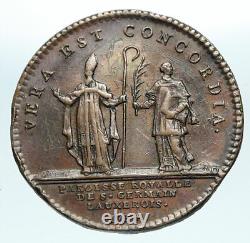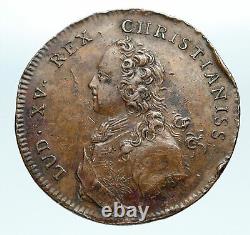
- Home
- Decade
- Features
- 8-day (19)
- Antique (31)
- Boxed (9)
- Carvings (26)
- Decorative (19)
- Dragon-antiques.com (6)
- Framed (32)
- Framed, Signed (7)
- Gilded (85)
- Gilded, Pair (93)
- Hand Painted (14)
- Limited Edition (8)
- One Of A Kind (ooak) (17)
- Ornate (19)
- Pair (151)
- Reclaimed (13)
- Roses Grapes (6)
- Salvage (49)
- Signed (17)
- Updated Wiring (8)
- ... (3409)
- Material
- Size
- Style
- Adams (10)
- Antique (63)
- Antique Style (15)
- Art Deco (27)
- Art Nouveau (42)
- Empire (25)
- France (11)
- French (493)
- French Country (29)
- French Empire (16)
- Louis Philippe (19)
- Louis Phillipe (13)
- Louis Xiv (64)
- Louis Xv (529)
- Louis Xvi (739)
- Miniature (18)
- Realism (20)
- Rococo (36)
- Traditional (15)
- Victorian (24)
- ... (1830)
- Type
1734 FRANCE King LOUIS XV Saint Germaine of Paris Antique FRENCH Medal i84101





Item: i84101 Authentic Medal of. French King: 1 September 1715 - 10 May 1774 Saint Germain of Paris 1734 Dated Bronze Token / Medal 31mm (9.49 grams) LUD. VERA EST CONCORDIA PAROISSE ROYALLE DE ST GERMAIN LAUXEROIS 1734, St Germain with staff and hat left, figure to right holding branch.
496 - 28 May 576 was the bishop of Paris and is a saint of the Eastern Orthodox Church and the Catholic Church. According to an early biography, he was known as Germain d'Autun, rendered in modern times as the "Father of the Poor".
Germain was born near Autun in what is now France, under Burgundian control 20 years after the collapse of the Western Roman Empire, to noble Gallo-Roman parents. Germain studied at Avallon in Burgundy and at Luzy under the guidance of his cousin Scallion, who was a priest.At the age of 35, he was ordained by Agrippinus of Autun and became abbot of the nearby Abbey of St. He was known for his hardworking and austere nature; however, it was his generous alms-giving which caused his monks to fear that one day he would give away all the wealth of the abbey, resulting in their rebellion against him.
While in Paris in 555, Sibelius, the bishop of Paris, died, and King Childebert had him consecrated as the bishop of Paris. Under Germain's influence, Childebert is said to have led a reformed life. In his new role, the bishop continued to practice the virtues and austerities of his monastic life, working to diminish the suffering caused by the incessant wars. He attended the Third and Fourth Councils of Paris (557, 573) and also the Second Council of Tours (566). He persuaded the king to stamp out the pagan practices existing in Gaul and to forbid the excess that accompanied the celebration of most Christian festivals. Childebert was succeeded briefly by Clotaire, who divided the royal demesnes among his four sons, with Charibert becoming King of Paris. Germain was forced to excommunicate Charibert in 568 for immorality. As his surviving brothers fought violently over his possessions, the bishop encountered great difficulty trying to establish peace, with little success. Sigebert and Chilperic, instigated by their wives, Brunehaut and the infamous Fredegund, went to war. Chilperic was defeated, and Paris fell into Sigebert's hands. Germain later wrote to Brunehaut, asking her to use her influence to prevent further war. However, Sigebert refused and, despite Germain's warning, set out to attack Chilperic at Tournai.Chilperic had fled, and Sigebert was later assassinated at Vitry in 575, under Fredegund's orders. Germain died the following year, before peace was restored.
For nine centuries, in times of plague and crisis, his relics were carried in procession through the streets of Paris. Two stained-glass panels depicting scenes from the life of Germain are in Metropolitan Museum of Art's Cloisters Collection.
Louis XV (15 February 1710 - 10 May 1774), known as Louis the Beloved , was a monarch of the House of Bourbon who ruled as King of France from 1 September 1715 until his death in 1774. He succeeded his great-grandfather Louis XIV at the age of five.
Until he reached maturity (then defined as his 13th birthday) on 15 February 1723, the kingdom was ruled by Philippe II, Duke of Orl? Ns, as Regent of France. Cardinal Fleury was his chief minister from 1726 until the Cardinal's death in 1743, at which time the young king took sole control of the kingdom. He ceded New France in North America to Spain and Great Britain at the conclusion of the disastrous Seven Years' War in 1763. He incorporated the territories of the Duchy of Lorraine and the Corsican Republic into the Kingdom of France.
He was succeeded in 1774 by his grandson Louis XVI, who was executed by guillotine during the French Revolution. Two of his other grandsons, Louis XVIII and Charles X, occupied the throne of France after the fall of Napoleon I. Historians generally give his reign very low marks, especially as wars drained the treasury and set the stage for the governmental collapse and French Revolution in the 1780s. France, officially the French Republic (French: République française), is a sovereign state comprising territory in western Europe and several overseas regions and territories. The European part of France, called Metropolitan France, extends from the Mediterranean Sea to the English Channel and the North Sea, and from the Rhine to the Atlantic Ocean. France spans 640,679 square kilometres (247,368 sq mi) and has a total population of 67 million. It is a unitary semi-presidential republic with the capital in Paris, the country's largest city and main cultural and commercial centre.The Constitution of France establishes the state as secular and democratic, with its sovereignty derived from the people. During the Iron Age, what is now Metropolitan France was inhabited by the Gauls, a Celtic people. The Gauls were conquered in 51 BC by the Roman Empire, which held Gaul until 486. The Gallo-Romans faced raids and migration from the Germanic Franks, who dominated the region for hundreds of years, eventually creating the medieval Kingdom of France.
France emerged as a major European power in the Late Middle Ages, with its victory in the Hundred Years' War (1337 to 1453) strengthening French state-building and paving the way for a future centralized absolute monarchy. During the Renaissance, France experienced a vast cultural development and established the beginning of a global colonial empire.
The 16th century was dominated by religious civil wars between Catholics and Protestants (Huguenots). France became Europe's dominant cultural, political, and military power under Louis XIV. French philosophers played a key role in the Age of Enlightenment during the 18th century. In 1778, France became the first and the main ally of the new United States in the American Revolutionary War.In the late 18th century, the absolute monarchy was overthrown in the French Revolution. Among its legacies was the Declaration of the Rights of Man and of the Citizen, one of the earliest documents on human rights, which expresses the nation's ideals to this day.
France became one of modern history's earliest republics until Napoleon took power and launched the First French Empire in 1804. Fighting against a complex set of coalitions during the Napoleonic Wars, he dominated European affairs for over a decade and had a long-lasting impact on Western culture. Following the collapse of the Empire, France endured a tumultuous succession of governments: the monarchy was restored, it was replaced in 1830 by a constitutional monarchy, then briefly by a Second Republic, and then by a Second Empire, until a more lasting French Third Republic was established in 1870. By the 1905 law, France adopted a strict form of secularism, called laïcité, which has become an important federative principle in the modern French society. France reached its territorial height during the 19th and early 20th centuries, when it ultimately possessed the second-largest colonial empire in the world. In World War I, France was one of the main winners as part of the Triple Entente alliance fighting against the Central Powers. France was also one of the Allied Powers in World War II, but came under occupation by the Axis Powers in 1940. Following liberation in 1944, a Fourth Republic was established and later dissolved in the course of the Algerian War. The Fifth Republic, led by Charles de Gaulle, was formed in 1958 and remains to this day.Following World War II, most of the empire became decolonized. Throughout its long history, France has been a leading global center of culture, making significant contributions to art, science, and philosophy. It hosts Europe's third-largest number of cultural UNESCO World Heritage Sites (after Italy and Spain) and receives around 83 million foreign tourists annually, the most of any country in the world. France remains a great power with significant cultural, economic, military, and political influence. It is a developed country with the world's sixth-largest economy by nominal GDP and eight-largest by purchasing power parity.
According to Credit Suisse, France is the fourth wealthiest nation in the world in terms of aggregate household wealth. It also possesses the world's second-largest exclusive economic zone (EEZ), covering 11,035,000 square kilometres (4,261,000 sq mi). French citizens enjoy a high standard of living, and the country performs well in international rankings of education, health care, life expectancy, civil liberties, and human development. France is a founding member of the United Nations, where it serves as one of the five permanent members of the UN Security Council. It is a member of the Group of 7, North Atlantic Treaty Organization (NATO), Organisation for Economic Co-operation and Development (OECD), the World Trade Organization (WTO), and La Francophonie.
France is a founding and leading member state of the European Union (EU). World-renowned expert numismatist, enthusiast, author and dealer in authentic ancient Greek, ancient Roman, ancient Byzantine, world coins & more.
Ilya Zlobin is an independent individual who has a passion for coin collecting, research and understanding the importance of the historical context and significance all coins and objects represent. Send me a message about this and I can update your invoice should you want this method. Getting your order to you, quickly and securely is a top priority and is taken seriously here. Great care is taken in packaging and mailing every item securely and quickly. What is a certificate of authenticity and what guarantees do you give that the item is authentic?
You will be very happy with what you get with the COA; a professional presentation of the coin, with all of the relevant information and a picture of the coin you saw in the listing. Additionally, the coin is inside it's own protective coin flip (holder), with a 2x2 inch description of the coin matching the individual number on the COA. Whether your goal is to collect or give the item as a gift, coins presented like this could be more prized and valued higher than items that were not given such care and attention to. When should I leave feedback?
Please don't leave any negative feedbacks, as it happens sometimes that people rush to leave feedback before letting sufficient time for their order to arrive. The matter of fact is that any issues can be resolved, as reputation is most important to me. My goal is to provide superior products and quality of service. How and where do I learn more about collecting ancient coins?Visit the Guide on How to Use My Store. For on an overview about using my store, with additional information and links to all other parts of my store which may include educational information on topics you are looking for.

